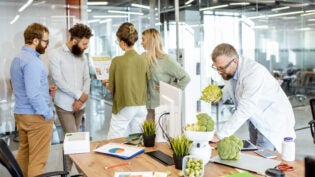
Whether you are an entrepreneur managing a startup, or a corporate executive with thousands of employees, it’s hard to ignore the evidence of big value from happy employees. According to a classic study from Deloitte, happy employees have been shown to be up to 20 percent more effective in the workplace than unhappy employees, as well as far more loyal and productive.
The challenge is to find the best way to keep everyone on your team happy and productive. Salesforce, which was ranked by Fortune magazine as the world’s best place to work in 2018, keeps the focus on employee happiness through dedicated “mindfulness” rooms, 56 hours of paid volunteer work a year, to $5.5 million in bounties paid out last year for great new hire referrals.
Unfortunately, I suspect that there is no simple formula that will work for all companies. Most experts agree that workplace happiness is hard to find, partially because we as humans are not particularly good at staying happy. Psychologist Ron Friedman, in his classic book “The Best Place To Work,” explores this problem, and I like the summary he offers to maximize your efforts:
- Reward frequency is more important than size. Business feedback indicates that smaller frequent positive feedback and rewards will keep people happy longer than a single large infrequent happy event. Even the biggest awards or raises “wear out” in less than a year, with most employees responding better to small doses every few days.
- Positive event variety prevents adaptation. People tend to discount events that happen repeatedly, no matter how positive. The value of going away on vacation is that it breaks the routine of everyday life, as well as making you recognize the pleasures of being back home. At work, variety could mean unique events or awards each month.
- Unexpected positive experiences deliver a bigger impact. When something surprising happens, our brains automatically pay closer attention, lending these events greater emotional weight. Thus you must make positive surprises more frequent, like special lunches or activities, to override the occasional unavoidable bad news.
- New life experiences have more impact than reward objects. Evidence indicates that providing new positive life experiences (for example, a hot-air balloon ride, wine-tasting class, or vacation to Italy) tends to provide a greater happiness boost than spending a comparable amount on material objects (flat-screen television, fancy suit, or purse).
- Happiness can be triggered outside of conscious awareness. Relaxing music can lift employee moods unconsciously, as can pleasing scents (nearby bakery, candles, or coffee). Stores and casinos use “aroma marketing” to put customers in positive moods, not for productivity, but to increase their optimism and willingness to spend.
- Focus on achievements leads to better job appreciation. Businesses need to spend more effort asking and listening to employee achievements, rather than a continuous focus on what’s broken or not done. Asking about achievements in a group setting encourages recognition of co-workers and gratitude expression, which catches on.
Research also shows that when team members are happy at work, they are better collaborators, work to common goals, and are more innovative. That means it pays to elevate people’s mood at the start of a team effort by using refreshments, good news, or an interactive activity. The trick is to promote a mindset that benefits the activities that you are asking them to undertake.
Managers and executives should never confuse recognition events and group lunches with unproductive time. All interactions that bring employees together in a positive way extend productivity in the long run. In a similar vein, don’t confuse people presence with productivity. Productive employees are the ones who are passionate, focused, and excited to be there.
Believe it or not, it is possible for employees in business, as well as entrepreneurs, to be both happy and productive. As a business, happy employees lead to success, more than success leads to happiness. If you want to emulate Salesforce’s success as a great place to work, and as a successful company, maybe it’s time to think more like they do about employee happiness.












